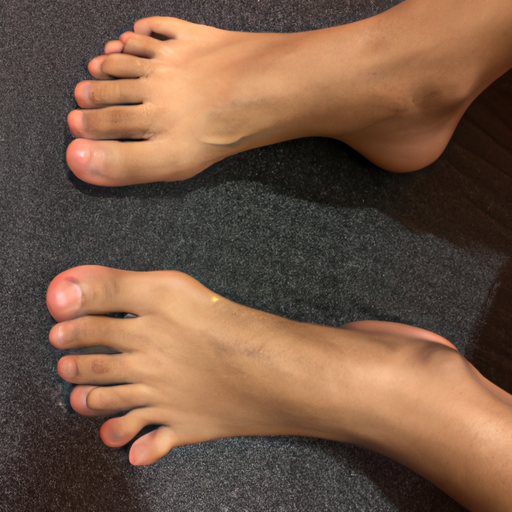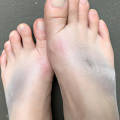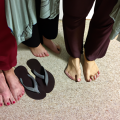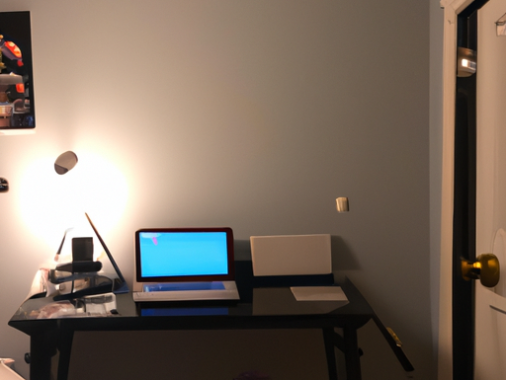-
Table of Contents
- Introduction
- How Long Does It Take to Feel the Benefits of Foot Reflexology?
- What Are the Most Common Side Effects of Foot Reflexology?
- What Are the Benefits of Foot Reflexology?
- How Can Foot Reflexology Help with Stress and Anxiety?
- What Are the Different Types of Foot Reflexology?
- How Can Foot Reflexology Help with Pain Management?
- What Are the Best Practices for Foot Reflexology?
- Q&A
- Conclusion
Introduction
Foot reflexology is a type of massage therapy that focuses on applying pressure to specific points on the feet. It is believed that these points correspond to different parts of the body, and that stimulating them can help to reduce stress and improve overall health. In this article, we will discuss what to expect after a foot reflexology session, including potential benefits and side effects. We will also provide tips on how to maximize the benefits of foot reflexology.
How Long Does It Take to Feel the Benefits of Foot Reflexology?
The effects of foot reflexology can be felt almost immediately, although the full benefits may take several sessions to be realized. During a reflexology session, pressure is applied to specific points on the feet that correspond to other parts of the body. This pressure helps to stimulate the body’s natural healing processes, which can lead to improved physical and mental wellbeing.
The effects of reflexology can vary from person to person, and the amount of time it takes to feel the benefits can depend on the individual’s overall health and the severity of their condition. Generally, people may start to feel the effects of reflexology after the first session, although the full benefits may take several sessions to be realized.
The effects of reflexology can include improved circulation, reduced stress and anxiety, improved sleep, and a sense of relaxation. People may also experience a reduction in pain and discomfort, improved digestion, and an overall sense of wellbeing.
In addition to the physical benefits, reflexology can also help to improve mental clarity and focus, reduce fatigue, and increase energy levels. It can also help to reduce the symptoms of depression and anxiety, and improve overall mood.
Overall, the effects of reflexology can be felt almost immediately, although the full benefits may take several sessions to be realized. With regular sessions, people can experience improved physical and mental wellbeing, as well as a sense of relaxation and improved overall health.
What Are the Most Common Side Effects of Foot Reflexology?
Foot reflexology is a type of massage therapy that involves applying pressure to specific points on the feet. It is believed to help promote relaxation and improve circulation. While it is generally considered to be safe, there are some potential side effects that may occur.
The most common side effects of foot reflexology include soreness, tenderness, and bruising. These effects are usually temporary and should resolve within a few days. Other potential side effects include headaches, dizziness, and fatigue. These effects may be more pronounced if the massage is too intense or if the person receiving the massage is not used to it.
In rare cases, foot reflexology may cause an allergic reaction. This may manifest as a rash, itching, or swelling. If this occurs, it is important to stop the massage and seek medical attention.
It is important to note that foot reflexology should not be used as a substitute for medical care. If you are experiencing any pain or discomfort, it is important to speak to your doctor before beginning any type of massage therapy.
What Are the Benefits of Foot Reflexology?
Foot reflexology is an ancient healing practice that has been used for centuries to promote relaxation and overall wellbeing. It is based on the belief that certain areas of the feet correspond to different organs and systems in the body. By applying pressure to these areas, reflexologists can help to reduce stress, improve circulation, and promote healing.
The benefits of foot reflexology are numerous. It can help to reduce stress and anxiety, improve circulation, and promote relaxation. It can also help to reduce pain, improve sleep, and boost the immune system. Additionally, it can help to improve digestion, reduce fatigue, and improve overall energy levels.
Foot reflexology can also help to improve mental clarity and focus. It can help to reduce mental fatigue and improve concentration. Additionally, it can help to reduce headaches and migraines, as well as improve mood and emotional wellbeing.
Foot reflexology can also help to improve the functioning of the lymphatic system. This can help to reduce inflammation and improve the body’s ability to fight off infection. Additionally, it can help to improve the functioning of the endocrine system, which can help to regulate hormones and improve overall health.
Finally, foot reflexology can help to improve the functioning of the nervous system. This can help to reduce stress and improve the body’s ability to cope with stress. Additionally, it can help to improve coordination and balance, as well as reduce muscle tension.
Overall, foot reflexology is a safe and effective way to promote relaxation and overall wellbeing. It can help to reduce stress, improve circulation, and promote healing. Additionally, it can help to improve mental clarity and focus, reduce pain, and improve sleep. Finally, it can help to improve the functioning of the lymphatic, endocrine, and nervous systems.
How Can Foot Reflexology Help with Stress and Anxiety?
Foot reflexology is an ancient healing practice that has been used for centuries to help reduce stress and anxiety. It is based on the idea that certain areas of the feet correspond to different organs and systems in the body. By applying pressure to these areas, reflexologists believe that they can help to reduce stress and anxiety.
The practice of foot reflexology involves applying pressure to specific points on the feet. These points are believed to correspond to different organs and systems in the body. By applying pressure to these points, reflexologists believe that they can help to reduce stress and anxiety.
Studies have shown that foot reflexology can help to reduce stress and anxiety. One study found that after a single session of foot reflexology, participants reported feeling more relaxed and less anxious. Another study found that after a series of foot reflexology sessions, participants reported feeling less stressed and more relaxed.
Foot reflexology can also help to improve overall health and wellbeing. It can help to reduce pain, improve circulation, and boost the immune system. It can also help to improve sleep quality and reduce fatigue.
Foot reflexology is a safe and natural way to reduce stress and anxiety. It is a non-invasive practice that can be done in the comfort of your own home. It is important to find a qualified reflexologist who is experienced in the practice of foot reflexology.
Foot reflexology is a great way to reduce stress and anxiety. It is a safe and natural practice that can help to improve overall health and wellbeing.
What Are the Different Types of Foot Reflexology?
Foot reflexology is a type of massage therapy that involves applying pressure to specific points on the feet. This type of massage is believed to have a positive effect on the body’s organs and systems, and can be used to treat a variety of ailments. There are several different types of foot reflexology, each with its own unique benefits.
The first type of foot reflexology is known as zone therapy. This type of massage focuses on the seven zones of the feet, which are believed to correspond to different parts of the body. Pressure is applied to specific points on the feet in order to stimulate the corresponding organs and systems. This type of massage is believed to be beneficial for relieving stress, improving circulation, and reducing pain.
The second type of foot reflexology is known as acupressure. This type of massage uses the same principles as acupuncture, but instead of using needles, pressure is applied to specific points on the feet. This type of massage is believed to be beneficial for relieving pain, improving circulation, and reducing stress.
The third type of foot reflexology is known as reflexology massage. This type of massage focuses on the reflex points on the feet, which are believed to correspond to different parts of the body. Pressure is applied to these points in order to stimulate the corresponding organs and systems. This type of massage is believed to be beneficial for relieving stress, improving circulation, and reducing pain.
Finally, the fourth type of foot reflexology is known as shiatsu. This type of massage uses the same principles as acupuncture, but instead of using needles, pressure is applied to specific points on the feet. This type of massage is believed to be beneficial for relieving pain, improving circulation, and reducing stress.
Each type of foot reflexology has its own unique benefits, and it is important to consult with a qualified massage therapist to determine which type is best for you.
How Can Foot Reflexology Help with Pain Management?
Foot reflexology is a form of massage therapy that has been used for centuries to help manage pain. It is based on the idea that certain areas of the feet correspond to different parts of the body, and that applying pressure to these areas can help to reduce pain and improve overall health.
Reflexology works by stimulating the nerve endings in the feet, which can help to reduce pain and tension in the body. This is done by applying pressure to specific points on the feet, which are believed to correspond to different organs and systems in the body. By stimulating these points, reflexology can help to reduce inflammation, improve circulation, and promote relaxation.
In addition to helping with pain management, foot reflexology can also help to reduce stress and anxiety, improve sleep, and boost the immune system. It can also help to improve digestion, reduce fatigue, and improve overall energy levels.
Foot reflexology is a safe and effective way to manage pain and improve overall health. It is important to note, however, that it is not a substitute for medical treatment. If you are experiencing chronic pain, it is important to consult with your doctor to determine the best course of treatment.
What Are the Best Practices for Foot Reflexology?
Foot reflexology is an ancient healing practice that has been used for centuries to promote relaxation and improve overall health. It is based on the belief that certain areas of the feet correspond to different organs and systems in the body. By applying pressure to these areas, reflexologists can help to reduce stress, improve circulation, and promote healing.
When it comes to foot reflexology, there are certain best practices that should be followed to ensure the best results. Here are some of the top tips for getting the most out of your reflexology session:
1. Make sure you are comfortable. Before beginning your session, make sure you are in a comfortable position. This will help you to relax and get the most out of your reflexology session.
2. Communicate with your reflexologist. Let your reflexologist know if you have any areas of discomfort or if you would like more or less pressure applied. This will help them to tailor the session to your needs.
3. Drink plenty of water. Drinking plenty of water before and after your session will help to flush out toxins and promote healing.
4. Avoid caffeine and alcohol. Caffeine and alcohol can interfere with the effectiveness of reflexology, so it is best to avoid them before and after your session.
5. Take your time. Don’t rush through your session. Take your time and allow your body to relax and adjust to the pressure.
By following these best practices, you can ensure that you get the most out of your foot reflexology session and experience the full benefits of this ancient healing practice.
Q&A
1. What kind of relief can I expect after a foot reflexology session?
You may experience a feeling of relaxation, improved circulation, and relief from pain and tension. You may also experience improved sleep, increased energy, and a sense of well-being.
2. How long will the effects of a foot reflexology session last?
The effects of a foot reflexology session can last anywhere from a few hours to a few days.
3. Are there any side effects associated with foot reflexology?
Generally, there are no side effects associated with foot reflexology. However, some people may experience temporary soreness or tenderness in the feet after a session.
4. Is foot reflexology safe for pregnant women?
Yes, foot reflexology is generally considered safe for pregnant women. However, it is important to consult with your doctor before beginning any type of reflexology treatment.
5. Is foot reflexology covered by insurance?
In most cases, foot reflexology is not covered by insurance. However, some insurance companies may cover certain types of reflexology treatments.
6. How often should I receive foot reflexology treatments?
The frequency of foot reflexology treatments will depend on your individual needs. Generally, it is recommended to receive treatments once a week or every other week.
7. What should I do to prepare for a foot reflexology session?
Before a foot reflexology session, it is important to wear comfortable clothing and remove any jewelry or watches. It is also important to drink plenty of water before and after the session.
Conclusion
Foot reflexology is a safe and effective way to reduce stress, improve circulation, and promote relaxation. It can also help to reduce pain, improve sleep, and improve overall health. After a session of foot reflexology, you can expect to feel relaxed, energized, and have improved circulation. You may also experience a decrease in pain and improved sleep. With regular sessions, you can expect to experience long-term benefits from foot reflexology.




